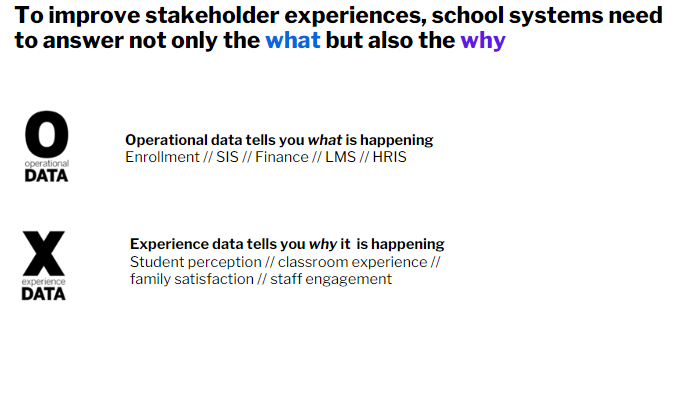Educators, students and parents have become more vocal about US education, especially on the local level. Many teachers are burned out, underpaid and dissatisfied. Parents worry about the students’ safety, academic progress and mental health. But people can become stuck when it comes to solutions and implementation, often because their ideas for a better school experience aren’t on the same page.
That’s where Bailey Cato Czupryk, the vice president of practices, diagnostics and impact at TNTP, and Frank Barnes, the chief accountability officer for Charlotte-Mecklenburg (N.C.) Schools, come in. They took part in a recent Education Week webinar facilitated by Byron Adams of Qualtrics, an engagement solutions software company, who shared information gleaned from a survey of 1,2000 K-12 families. Together, they explained how to build a better school experience.
TNTP’s work in classrooms over several years has revealed that, despite changing or strengthening education standards, instruction “has not changed all that much, because we haven’t provided teachers the support they needed,” Czupryk said. In addition, teachers often think they’re helping students catch up, but students don’t always agree.
“We wondered what that feels like. What does it feel like to be a student in a fifth-grade math class doing second-grade math work?”
The answer: Ask them.
5 steps toward a better school experience
1. Ask the right questions, of the right people, often.
Each educator, staff member and student brings different experiences and perceptions onto a school campus. Not all students or teachers or races or genders or cultures are the same. Nor are people within each demographic. Socioeconomic factors create more distinctions, as does whether a person is just having a good or bad day.
Asking the right questions of the right people is better than guessing or assuming, and it can yield actionable, effective results.
“Conversation is one of the best ways to know what students’ views or experiences are — to ask them and to listen to them and then respond to what they’re saying,” Barnes said.
The school culture, or climate, is a good place to start. An annual student survey at each Charlotte-Mecklenburg school asks questions about a student’s experiences and relationships. Adams says his company’s survey questions include, “Do you feel safe at school?” “Do you feel like the environment is conducive to learning?”
The answers are important, because “if I’m a student, and I don’t feel safe at my school or my classroom, how can I be open or receptive to a potential lesson?” Adams asked.
Czupryk recommends formally or informally surveying students frequently, especially when it comes to academics, so teachers get feedback within a couple of days.
Once educators have answers, they can strategize about what needs to happen.
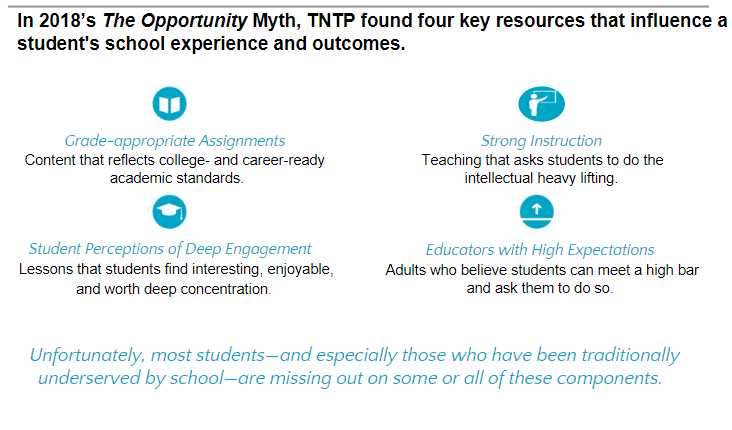
2. Ensure emotional, academic and safety support for every student
Students need multiple opportunities to share feelings, academic and safety concerns, and they need to know what to expect when they do.
“If you say you don’t feel like you fit in or say you need help, you can expect a grown-up in your school to follow up to try to figure out how to create an environment that’s more supportive,” Czupryk tells students.
Teachers can build relationships with students to better aid the academic and social-emotional process. For example, a psychological struggle of varying degrees always ensues during an academic struggle. Teachers who can tell a student is about to disengage can learn to change the experience so learning can continue.
Students need to know their teachers believe in them. “Teachers can say, ‘I’m giving you this feedback on something you need to do better, because I believe you can do it better, because I believe you can be successful,’ ” Czupryk said. They need to know the teacher will support them through the process.
It’s also important for students to know that “they can fail without being failures,” Barnes said, using weight-lifting as an analogy. It requires doing something through repetition and maybe ending up with muscle failure — at which point you step back, recover and do it again, repeating the process to build strength. In schools, this process is just an intellectual adventure, and it leads to a better school experience.
Frequent touchpoints and feedback are crucial to making students feel that they’re known, they belong and they’re supported. Alternatively, when students share into a black hole, distrust builds.
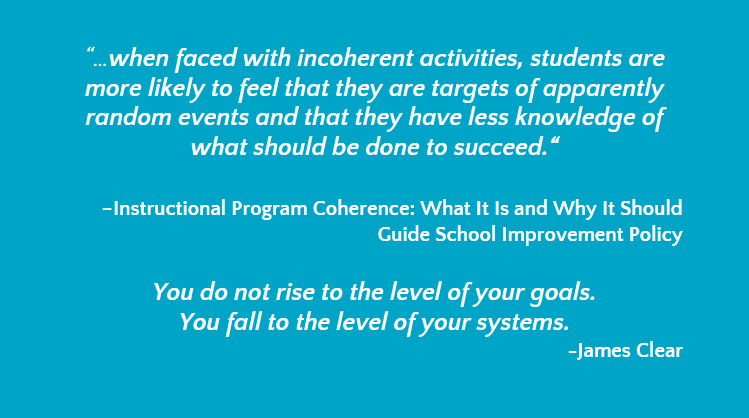
3. Raise your expectations
Academic efforts in the wake of the pandemic have not always been successful. “We’d say, ‘We’re going to teach them where they are … but they never got up to here,” Barnes said, indicating a higher grade-level goal with his hand. “We never, ever instructionally got them here. What [educators] thought they were teaching and what [students] were actually experiencing weren’t the same.”
That method seems to have confused students. And worse, that below-level work more often was given to students in historically marginal communities. A better option, Czupryk said, is giving kids grade-level content, and only adding “really strategic, below-grade-level support when we see that they need it because they’re struggling.” That creates a more coherent experience for kids, “and they’re better able to understand the content we’re putting in front of them than if we get them to jump around and try to fill in everything.”
Charlotte-Mecklenburg has reconnected students and standards. What students were being asked to do and what they were able to do were different, Barnes said. The educators unpacked the standards, connected them to curriculum and designed lessons to the standards. “Now, some of our schools that had the highest concentration of poverty actually had the highest growth in the state,” he said.
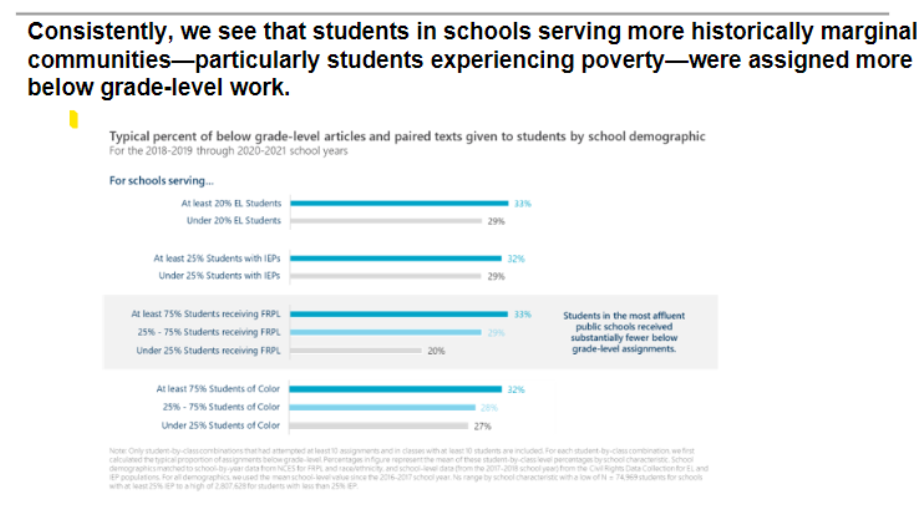
4. Build strong partnerships
Schools can’t do it alone.
“We need partners to provoke us into thinking about how to recodify, monitor and measure and act on those leading indicators. And we also need a set of partners to help us get the tools in place,” Barnes said.
Even a large district like his “still didn’t have all the tools or even necessary perspectives we needed to be able to execute.”
Partners need to be friends, as well as offer access to tangible tools, he said.
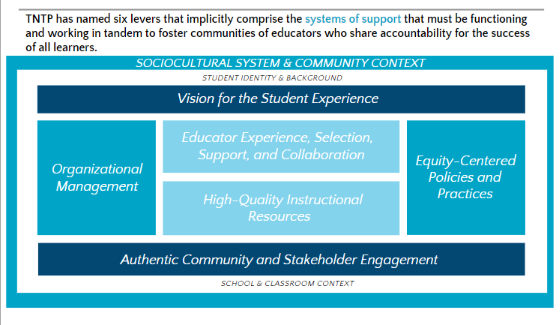
5. Create priorities together
Educators who ask questions may end up with 35 different answers to 35 different queries, and that’s where solutions and implementation get tricky.
Schools need to ensure data from student and educator surveys gets to the right people in a timely manner. When a school or district can’t do everything at once, it needs a core group with the discipline to decide on two or three things that can happen during a given time frame.
That involves more questions, Adams said. What can they do to change experiences? What are the key levers they need in order to take action on data? Can any of it be automated?
To make this process work, educators, too, need to feel comfortable with their school culture. They need positive relationships with each other. And they need the opportunity to progress and to recover, the grace of knowing they can fail without being failures. That’s what leads to innovation and a better school experience.
The webinar is available to view as watch-on-demand.
Diane Benson Harrington is an education writer at SmartBrief. Reach out to her via email, Twitter or LinkedIn.
Opinions expressed by SmartBrief contributors are their own.
_________________________
Subscribe to SmartBrief’s FREE email ASCD newsletter to see the latest hot topics in education. It’s among SmartBrief’s more than 250 industry-focused newsletters.
